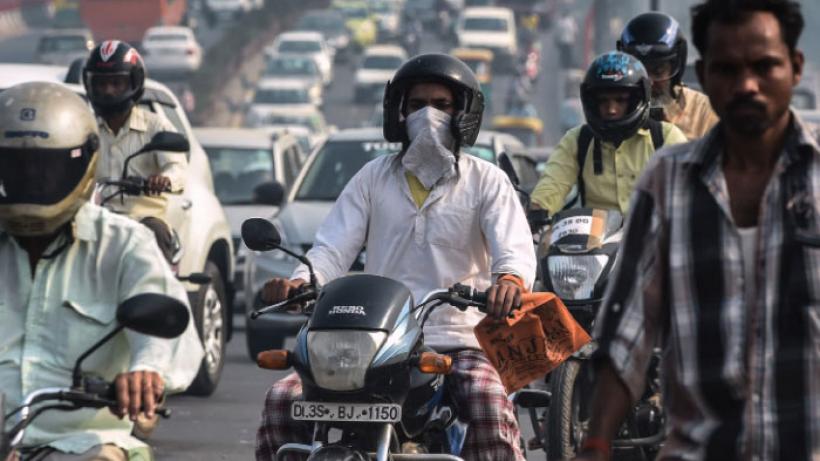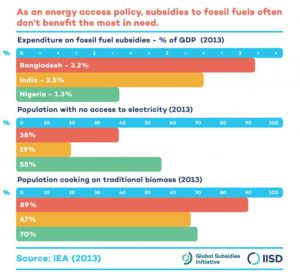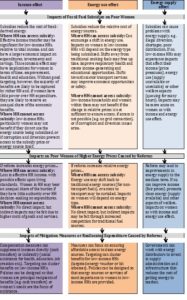
Reforming fossil fuel subsidies provides opportunity to better target government support towards women and children
A new report from the Global Subsidies Initiative of the International Institute for Sustainable Development (IISD) finds that Bangladeshi, Indian and Nigerian governments can significantly curb poverty among women and children in their countries by redesigning fossil fuel subsidies.
Fossil Fuel subsidies fail to reach households with greatest needs
Globally, governments spent about USD 500 billion in 2014 on consumer subsidies for fossil fuels. Although policies for energy subsidies typically aim to increase low-income households’ access to modern energy, a large body of evidence finds that, in practice, these policies are inefficient and poorly target. They often benefit richer households more than poorer ones. Bangladesh, India and Nigeria are currently engaged in attempts to reform their fossil fuel subsidies, through programs such as India’s PAHAL scheme, which works to cut out unintended beneficiaries of LPG subsidies, and Nigeria’s “price modulation” policy, which has adjusted prices for gasoline and kerosene twice since January 2016.
Yet one key question remains largely unexplored: Do existing subsidies – and policies to reform them – affect men and women differently? This is a critical knowledge gap, and without a solid evidence base, how can governments tailor policies to ensure that they promote both women’s and men’s welfare, and improve gender equality, rather than undermine it?
Women pay the biggest price for poorly designed subsidies
The report explores this question in great detail and finds a lack of systematic examinations of the gender-differentiated impact of energy subsidies and potential reforms. Furthermore that policy impacts and responses are highly context-specific. Nevertheless, it is clear that subsidies and their reform do have implications for poor women (as outlined in the table below). The evidence suggests that poor women pay the biggest price when household fuel subsidies are badly designed. In Bangladesh, India and Nigeria, poor households still have critically low levels of energy access (such as modern lighting and cooking fuels). As an effort to increase energy access, current subsidies intended to support poorer household often fail to meet their objectives.

The report’s findings underscore that government resources could be better spent on targeted sustainable energy access interventions – like for cooking, LPG subsidies that are targeted to the poor and that exclude the rich from sharing the benefits. For lighting, governments can support electrification and new technologies like small-scale solar power systems and appliances.
The report also identifies the key ways that women in poverty can be negatively affected when subsidies are reformed for cooking and lighting fuels. Weak subsidy reform can affect income, particularly if it raises the cost of energy; this in turn can encourage greater use of traditional biomass fuels over more modern cooking fuels.
Likely impacts on poor women from fossil fuel subsidies, reform and mitigation measures

Source: Authors
“Since subsidy reforms in January, the problems with kerosene supply have been almost worse than before”, reports Victoria Ohaeri, project researcher and CEO of Spaces for Change, in Lagos, Nigeria. “We need a well-thought out plan that includes investment in sustainable energy supply and distribution too, so that these reforms will work for women”.
The study encourages governments to examine how women and men will be affected by subsidies and reform policies. It also encourages using the resulting knowledge, to design more targeted – and effective – interventions, listed below, that positively targets poor women and those most likely to be affected:
- Increasing cash transfers;
- Targeting gas and electricity coupons or tariffs;
- Overcoming upfront costs to cleaner cooking by providing assets (e.g. clean cookstoves); and
- Increasing broader social safety nets targeted at women’s needs e.g. healthcare and education.
Expanding the evidence base to shape further reforms
This report is part of an initiative to establish an evidence base on subsidy–access relationship for women in low-income households. More specifically, in the coming few years, the research will gather evidence of the impact of cooking and lighting fuel subsidies on women in low-income households in Bangladesh, India and Nigeria, as well as the likely impact of the reforms under consideration in each country. Such reforms include the Indian government’s efforts to provide LPG subsidies (in 2014 and again in 2015) through a cash transfer scheme, and recent changes in Nigerian policy to remove subsidies on kerosene (in 2016). The research will focus in particular on understanding the way that subsidy policies do or do not flow through into improved access to cooking and lighting fuels liquefied petroleum gas (LPG), kerosene and electricity) and what this means for women in low-income households.

